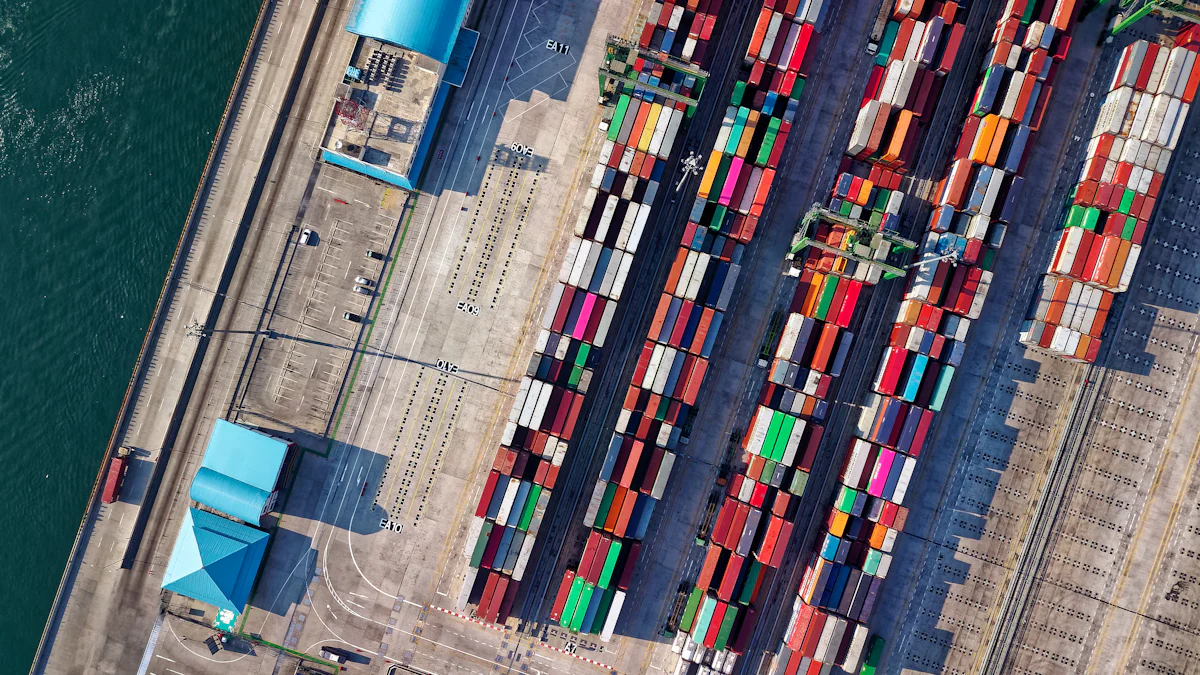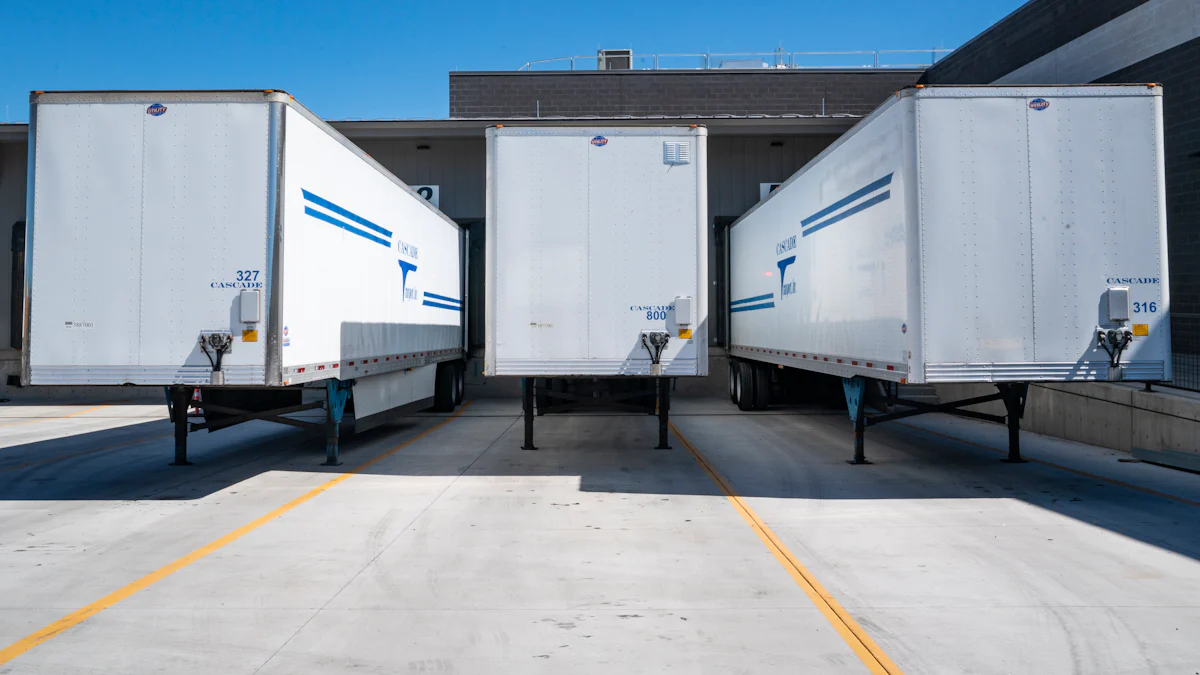Top 10 Real-Time Supply Chain Technology Trends in 2024

Real-time supply chain technology revolutionizes supply chain management. Organizations leverage real-time data and end-to-end visibility to meet consumer demand efficiently. Rapid technological advancements in 2024 drive this transformation. Technologies like AI, IoT, and blockchain enhance real-time supply chain efficiency, innovation, and strategic planning. Real-time analytics optimize inventory control and last-mile delivery. A survey reveals that 95% of respondents focus on strengthening relationships with suppliers or buyers. Additionally, 75% use digital solutions for real-time supply chain visibility and risk identification. Embracing these technologies ensures a competitive edge in the evolving market.
Real-Time Supply Chain Trends

Artificial Intelligence and Machine Learning
Predictive Analytics
Artificial Intelligence (AI) and Machine Learning (ML) revolutionize supply chain management. Predictive analytics, powered by AI, forecasts demand accurately. This technology analyzes historical data to predict future trends. Companies can optimize inventory levels and reduce waste. Predictive analytics also enhances customer satisfaction by ensuring product availability.
Automation in Decision-Making
AI and ML automate decision-making processes. These technologies analyze real-time data to make informed decisions. Automation reduces human error and increases efficiency. AI-driven systems can manage complex supply chain operations seamlessly. This leads to cost savings and improved operational performance.
Internet of Things (IoT)
Real-Time Tracking
The Internet of Things (IoT) enables real-time tracking of assets. IoT devices monitor the location and condition of goods throughout the supply chain. This technology provides end-to-end visibility, enhancing transparency. Real-time tracking helps companies respond quickly to disruptions. It ensures timely delivery and reduces delays.
Enhanced Visibility
IoT enhances visibility across the supply chain. Sensors collect data on various parameters such as temperature and humidity. This information helps maintain product quality during transit. Enhanced visibility allows for better risk management. Companies can identify potential issues and take preventive measures.
Blockchain Technology
Secure Transactions
Blockchain technology ensures secure transactions in the supply chain. Each transaction gets recorded in a decentralized ledger. This makes it tamper-proof and highly secure. Blockchain reduces fraud and increases trust among stakeholders. Companies can verify the authenticity of products and transactions easily.
Traceability
Blockchain provides traceability in the supply chain. Each product's journey gets documented from origin to destination. This enhances accountability and transparency. Traceability helps in identifying and addressing issues promptly. It also builds consumer trust by ensuring product authenticity.
Advanced Robotics
Warehouse Automation
Advanced robotics revolutionizes warehouse operations. Automated robots handle repetitive tasks efficiently. These robots increase productivity and reduce labor costs. Companies use robotics to streamline inventory management. Robotic systems ensure accurate order fulfillment. This technology minimizes human error and enhances operational efficiency. Real-time supply chain benefits from faster processing and reduced downtime.
Autonomous Vehicles
Autonomous vehicles transform logistics and transportation. Self-driving trucks and drones deliver goods with precision. These vehicles operate without human intervention. Companies achieve significant cost savings and improved delivery times. Autonomous vehicles navigate complex routes using advanced algorithms. Real-time supply chain visibility improves with constant data updates. This technology ensures timely deliveries and reduces transportation risks.
Big Data Analytics
Data-Driven Decision Making
Big data analytics empowers companies to make informed decisions. Analyzing vast amounts of data reveals valuable insights. Companies optimize supply chain operations based on these insights. Data-driven decision making enhances efficiency and reduces costs. Real-time supply chain data enables quick responses to market changes. This approach improves overall performance and competitiveness.
Risk Management
Big data analytics plays a crucial role in risk management. Companies identify potential risks through data analysis. Predictive models forecast disruptions and mitigate their impact. Real-time supply chain monitoring detects anomalies promptly. This proactive approach minimizes losses and ensures business continuity. Companies build resilient supply chains by leveraging big data analytics.
Cloud Computing
Scalability and Flexibility
Cloud computing offers scalability and flexibility to supply chains. Companies scale operations up or down based on demand. Cloud-based systems provide real-time supply chain data access. This flexibility enhances responsiveness to market fluctuations. Companies reduce infrastructure costs by using cloud services. The cloud ensures seamless integration of new technologies.
Collaboration and Integration
Cloud computing facilitates collaboration across the supply chain. Stakeholders share information in real-time, enhancing coordination. Integrated systems streamline communication and data exchange. Companies achieve better alignment with suppliers and partners. Real-time supply chain data improves decision-making and efficiency. Cloud-based platforms support agile and adaptive supply chain strategies.
5G Technology
Enhanced Connectivity
5G technology revolutionizes the real-time supply chain by providing enhanced connectivity. Faster data transmission speeds enable instant communication between supply chain components. Companies can monitor and control operations without delays. Enhanced connectivity ensures seamless integration of various technologies. This leads to improved efficiency and responsiveness in the supply chain.
IoT and Device Integration
5G technology facilitates the integration of IoT devices in the real-time supply chain. High-speed networks support a vast number of connected devices. IoT sensors collect and transmit data in real-time. This integration provides comprehensive visibility into supply chain operations. Companies can track assets, monitor conditions, and optimize processes. Real-time data from IoT devices enhances decision-making and reduces risks.
Augmented Reality (AR) and Virtual Reality (VR)
Training and Simulation
Augmented Reality (AR) and Virtual Reality (VR) transform training and simulation in the real-time supply chain. AR and VR provide immersive training experiences for employees. Workers can practice complex tasks in a virtual environment. This reduces training costs and improves skill levels. Simulations help identify potential issues and test solutions. Companies can enhance workforce readiness and operational efficiency.
Enhanced Visualization
AR and VR offer enhanced visualization capabilities in the real-time supply chain. These technologies provide detailed views of supply chain processes. Managers can visualize warehouse layouts and optimize space utilization. AR overlays real-time data on physical objects, aiding in quick decision-making. Enhanced visualization improves accuracy and reduces errors. Companies can achieve better planning and execution of supply chain activities.
Cybersecurity
Protecting Supply Chain Data
Cybersecurity is crucial for protecting data in the real-time supply chain. Advanced security measures safeguard sensitive information from cyber threats. Encryption and authentication protocols ensure data integrity. Companies can prevent unauthorized access and data breaches. Robust cybersecurity practices build trust among stakeholders. Protecting supply chain data is essential for maintaining business continuity.
Ensuring Business Continuity
Cybersecurity ensures business continuity in the real-time supply chain. Proactive measures detect and mitigate cyber threats promptly. Companies can respond to incidents without disrupting operations. Regular security audits and updates strengthen defenses. Ensuring business continuity minimizes financial losses and reputational damage. A secure supply chain enhances resilience and reliability.
Sustainable Technologies
Green Logistics
Green logistics focuses on reducing the environmental impact of supply chain operations. Companies adopt eco-friendly practices to minimize carbon footprints. Electric vehicles replace traditional fuel-powered trucks for transportation. Renewable energy sources power warehouses and distribution centers. Packaging materials shift towards biodegradable options. These measures contribute to a sustainable real-time supply chain.
Green logistics also involves optimizing routes to reduce fuel consumption. Advanced algorithms calculate the most efficient paths for delivery. This reduces emissions and operational costs. Companies monitor real-time supply chain data to identify areas for improvement. Implementing green logistics enhances corporate social responsibility and attracts environmentally conscious consumers.
Energy Efficiency
Energy efficiency plays a crucial role in sustainable supply chain management. Companies invest in technologies that reduce energy consumption. Smart sensors and IoT devices monitor energy usage in real-time. Data analytics identify inefficiencies and suggest optimization strategies. Energy-efficient equipment and lighting systems lower operational costs.
Renewable energy integration further boosts energy efficiency. Solar panels and wind turbines generate clean energy for supply chain facilities. Battery storage systems ensure a steady energy supply during peak demand. Real-time supply chain monitoring enables quick adjustments to maintain optimal energy usage.
Energy efficiency initiatives also extend to manufacturing processes. Companies adopt lean manufacturing principles to minimize waste. Automation and robotics enhance precision and reduce energy consumption. Real-time data collection helps track progress and measure the impact of energy-saving measures.
The top 10 real-time supply chain technology trends in 2024 include AI, IoT, blockchain, advanced robotics, big data analytics, cloud computing, 5G technology, AR/VR, cybersecurity, and sustainable technologies. Staying updated with these advancements ensures a competitive edge. Supply chain professionals should:
Adopt predictive analytics for demand forecasting.
Implement IoT devices for real-time tracking.
Utilize blockchain for secure transactions.
The future of real-time supply chain technology promises enhanced efficiency, resilience, and sustainability. Embracing these innovations will drive success in the evolving market.
See Also
Tomorrow's Logistics: 5 Key Trends for Efficient Supply Chains
Artificial Intelligence in Logistics: Transforming Future Supply Chains
Industry Transformation: The Impact of Cloud Supply Chain Solutions
Ready for Change? Delving into Cutting-Edge Transport Tech for Supply Chains
Revealing AI Integration Insights for the Supply Chain of Tomorrow
